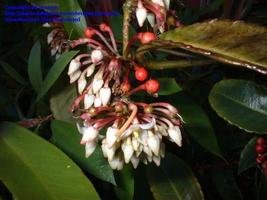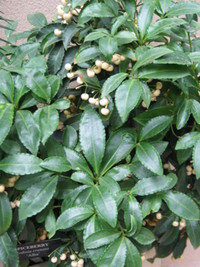





Anyone who views up close a mass of coral ardisia would naturally want it for their landscape, for it is very attractive. Sometimes called coral berry, spice berry, hen's eyes and other descriptive names, this small upright shrub is a trickster of the meanest sort. It is a prime example of why gardeners should learn about the plants they invite into their gardens.
(Editor's Note: This article was originally published on February 4, 2010. Your comments are welcome, but please be aware that authors of previously published articles may not be able to respond to your questions.)
Coral ardisia (Ardisia crenata), a native of Japan and northern India, is a member of the Myrsinaceae family. Plants grow anywhere from 2 to 6 feet tall, usually in multi-stemmed clumps, and are hardy in Zones 8-10. Plants bear large (to 8.3 inches), glossy, evergreen leaves that are attractively serrated. In spring inconspicuous white to pinkish flowers bloom in axillary clusters that are largely hidden by the foliage. Showy berries follow the flowers, starting out green and gradually turning bright red. The berries hang on throughout the winter or until they are eaten by cedar waxwings, mockingbirds, raccoons, and other small mammals.
Already you may have gleaned what part of the problem is. Not only does ardisia reseed freely and form large colonies, the seeds are scattered wherever birds fly and germinate readily whenever they land on suitable ground.
History
Like many other exotic invasive plants, coral ardisia was introduced as an ornamental. Royal Palm Nurseries in Florida sold it in the early 1900s. It was not until 1982 that it began to be a problem. Then by 1997 it had spread to Texas, where it dominated the understory of two nature preserves. It can now be found in natural areas in other southeastern states, including Louisiana, Alabama, and Georgia. The pernicious weed infests all of Hawaii's major islands.
Why is Coral Ardisia Bad?
All those beautiful red berries help to explain the problem. Viable seeds remain on the plant year round, and they have a germination rate of 84 to 98%. Usually a carpet of seedlings surrounds the base of a mature plant. A one-meter square area can support as many as 100 plants. This thick cover prohibits sunlight from reaching the ground so that native groundcovers such as violets and trilliums are unable to compete. It takes only two years for a seedling to produce viable seed.
Most control methods are exercises in futility. It resprouts quickly after a fire, so burning will not control its spread. It resprouts quickly after cutting, and attempting to control it with herbicides puts other plants at risk. Pulling it up from the roots leaves a loose soil just right for thousands of seeds that are left behind to germinate. Plants are highly adaptable to a wide range of soil types from acidic to alkaline, so they come up almost anywhere.
Coral Ardisia is a Category I exotic invasive species on the Florida Exotic Pest Council's (FLEPPC) list. According to the FLEPPC, "Invasive exotic plants are termed Category I invasives when they are altering native plant communities by displacing native species, changing community structures or ecological functions, or hybridizing with natives. This definition does not rely on the economic severity or geographic range of the problem, but on the documented ecological damage caused." It is also listed as invasive by other sources.
Coral Ardisia is sold in most nurseries. Gardeners in most of the country do not need to worry, because it is hardy only in Zones 8B and higher. Those who live in areas where it is hardy are strongly discouraged from planting this plant in their landscapes, and furthermore, to remove any that is already growing. The length of time from its introduction to the time it was first noted as being invasive in Florida (1900-1982) points out a significant lag time. With populations already established in Georgia, Louisiana, and Texas, it seems only a matter of time before this plant is invasive in all parts of its hardiness range.
Copyright © www.100flowers.win Botanic Garden All Rights Reserved